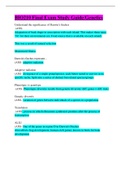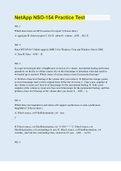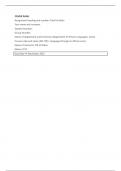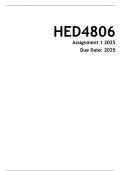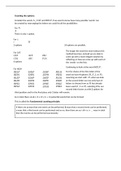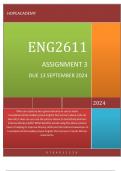NRNP 6675 WEEK 6 VERSION 2 (100 QUESTIONS AND
ANSWERS COMPLETE SULUTION AALREADY A GRADED
[School]
[Course title]
,Sarah, who is postmenopausal, has controlled asthma, hypertension being effectively
treated with medication, and smokes cigarettes. She has a low-density lipoprotein (LDL)
cholesterol level of 170 mg/dL and a high-density lipoprotein (HDL) cholesterol level of
40 mg/dL. To reduce Sarah ' s risk of a coronary event, the treatment plan would focus
on
A. lowering her LDL cholesterol level.
B. lowering her HDL cholesterol level.
C. aggressively treating and controlling her hypertension and asthma.
D. getting Sarah to stop smoking. - A
The most common cause of elevated total and low-density lipoprotein cholesterol levels
in the United States is
A. heredity
B. hypothyroidism
C. diabetes
D. a diet high in saturated fat - D
Which of the following statements about hypertension is true?
A. It is frequently caused by pheochromocytoma
B. It is usually the result of an underlying, correctable problem
C. The cause is unknown in approximately 95% of cases
D. It has a higher incidence among adult white men than any other group - C
What value on the ABI diagnoses PAD?
A. Less than 0.25
B. Less than 0.50
C. Less than 0.9
D. 1 or greater - D
Harry, age 54, comes to your office with waxing and waning ischemic symptoms over a
period of days and weeks, an increase in angina while at rest, and transient ST changes
on his EKG. This presentation leads you to believe that he is experiencing
A. a brain attack (stroke, CVA)
B. a myocardial infarction
C. stable angina
D. unstable angina - D
Pharmacological therapy for mitral valve disease in adults includes
A. treatment of dyspnea with diuretics to relieve congestion
B. reduction of fast ventricular rates with beta blockers or calcium channel blockers
, C. preload reduction with antihypertensive agents to decrease regurgitant flow
D. daily antibiotic use to ward off bacterial infections - A
Some older adults develop postural hypotension with hypertensive drug therapy. What
is included in your teaching with these individuals?
A. Drug therapy will be d/c'ed as soon as their blood pressure stabilizes to prevent this
problem from recurring
B. Slight dehydration will prevent postural hypotension from occurring
C. Clients should sleep in a high Fowler's position to prevent this from happening
D. Clients should be taught to sit on the edge of the bed before standing - D
When a client is getting ready for a cardiac catheterization, which question is essential
to ask?
A. "Are you allergic to shellfish?"
B. "Have you ever had a catheterization before?"
C. "Have you completed an advanced directive?"
D. "What current medications are you on?" - A
Which would be the LAST step you would consider in a client with long-term chronic
ischemic heart disease?
A. Use of aspirin
B. Use of beta blockers, CCBs, and nitrates
C. Risk factor and lifestyle modifications
D. A coronary angiogram - D
When teaching a client with hypertension about restricting dietary sodium, you would
include which of the following instructions?
A. Sodium restriction can cause serious adverse effects
B. Diets with markedly reduced intake of sodium may be associated with other
beneficial effects beyond blood pressure control
C. 75% of sodium intake is derived from processed food
D. A goal of 3g of Na or 1.2g of sodium per day is easily achievable - C
Margie, age 45, comes into your office as a new patient and says that she has been on
nicotinic acid to treat her serum hyperlipidemia for years. What do you tell her?
A. "There has been no evidence to show that this works. Let's change you to a statin."
B. "Boy, your old provider is antiquated."
C. "If you've been on it for years, and it's working, let's just keep monitoring your levels."
D. "Let's eliminate the nicotinic acid for a few months to determine your baseline
cholesterol levels." - C
ANSWERS COMPLETE SULUTION AALREADY A GRADED
[School]
[Course title]
,Sarah, who is postmenopausal, has controlled asthma, hypertension being effectively
treated with medication, and smokes cigarettes. She has a low-density lipoprotein (LDL)
cholesterol level of 170 mg/dL and a high-density lipoprotein (HDL) cholesterol level of
40 mg/dL. To reduce Sarah ' s risk of a coronary event, the treatment plan would focus
on
A. lowering her LDL cholesterol level.
B. lowering her HDL cholesterol level.
C. aggressively treating and controlling her hypertension and asthma.
D. getting Sarah to stop smoking. - A
The most common cause of elevated total and low-density lipoprotein cholesterol levels
in the United States is
A. heredity
B. hypothyroidism
C. diabetes
D. a diet high in saturated fat - D
Which of the following statements about hypertension is true?
A. It is frequently caused by pheochromocytoma
B. It is usually the result of an underlying, correctable problem
C. The cause is unknown in approximately 95% of cases
D. It has a higher incidence among adult white men than any other group - C
What value on the ABI diagnoses PAD?
A. Less than 0.25
B. Less than 0.50
C. Less than 0.9
D. 1 or greater - D
Harry, age 54, comes to your office with waxing and waning ischemic symptoms over a
period of days and weeks, an increase in angina while at rest, and transient ST changes
on his EKG. This presentation leads you to believe that he is experiencing
A. a brain attack (stroke, CVA)
B. a myocardial infarction
C. stable angina
D. unstable angina - D
Pharmacological therapy for mitral valve disease in adults includes
A. treatment of dyspnea with diuretics to relieve congestion
B. reduction of fast ventricular rates with beta blockers or calcium channel blockers
, C. preload reduction with antihypertensive agents to decrease regurgitant flow
D. daily antibiotic use to ward off bacterial infections - A
Some older adults develop postural hypotension with hypertensive drug therapy. What
is included in your teaching with these individuals?
A. Drug therapy will be d/c'ed as soon as their blood pressure stabilizes to prevent this
problem from recurring
B. Slight dehydration will prevent postural hypotension from occurring
C. Clients should sleep in a high Fowler's position to prevent this from happening
D. Clients should be taught to sit on the edge of the bed before standing - D
When a client is getting ready for a cardiac catheterization, which question is essential
to ask?
A. "Are you allergic to shellfish?"
B. "Have you ever had a catheterization before?"
C. "Have you completed an advanced directive?"
D. "What current medications are you on?" - A
Which would be the LAST step you would consider in a client with long-term chronic
ischemic heart disease?
A. Use of aspirin
B. Use of beta blockers, CCBs, and nitrates
C. Risk factor and lifestyle modifications
D. A coronary angiogram - D
When teaching a client with hypertension about restricting dietary sodium, you would
include which of the following instructions?
A. Sodium restriction can cause serious adverse effects
B. Diets with markedly reduced intake of sodium may be associated with other
beneficial effects beyond blood pressure control
C. 75% of sodium intake is derived from processed food
D. A goal of 3g of Na or 1.2g of sodium per day is easily achievable - C
Margie, age 45, comes into your office as a new patient and says that she has been on
nicotinic acid to treat her serum hyperlipidemia for years. What do you tell her?
A. "There has been no evidence to show that this works. Let's change you to a statin."
B. "Boy, your old provider is antiquated."
C. "If you've been on it for years, and it's working, let's just keep monitoring your levels."
D. "Let's eliminate the nicotinic acid for a few months to determine your baseline
cholesterol levels." - C

